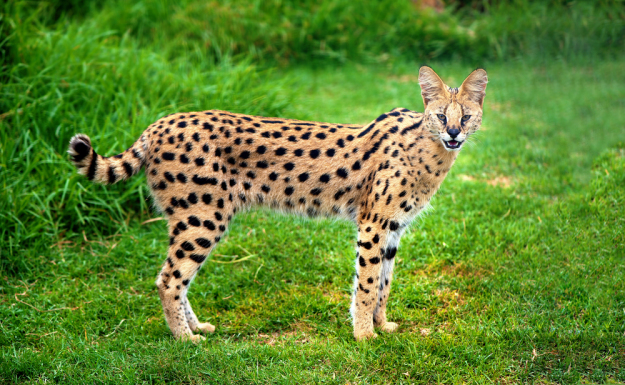
The Serval(Leptailurus serval), is a solitary wild cat that lives in Africa. It is the only felid classified in the genus Leptailurus.
| Genus | Leptailurus |
| Species | L. serval |
| Binomial Name | Leptailurus serval |
| Length | 59 cm to 1 m(1’11.2 to 3’3.4”) |
| Shoulder Height | 45-60 cm(1’5.7”-1’11.6”) |
| Weight | 7-18 kg(15.4-39.7 lbs.) |
| Diet | Carnivore |
| IUCN Status | Least Concern |
Range and Habitat
The Serval inhabits grasslands throughout much of Africa.
Physical Characteristics
A Serval’s coat is spotted and striped, and is a tawny color. It’s belly is white. Servals have small heads and long ears.The Serval has a whitish chin with spots and streaks on its forehead and face.
Reproduction
A female Serval gives birth to 1 to 5 kittens after a gestation period of 2 to 3 months. The kittens are born in a hidden location such as dense vegetation or an abandoned animal burrow. The newborn kittens weigh from 227 to 255 grams(8 to 9 ounces). The kittens are born blind; it takes up to 13 days for their eyes to open. The kittens are weaned after 1 month; they begin catching their own prey at 6 months old. The kittens leave their mother after about 1 year and It takes up to 2.08 years for the kittens to reach sexual maturity.
Diet
Servals eat rodents, small birds, frogs, hares, small antelope(especially the young), crabs, insects, and reptiles.
Fun Facts
- The Serval has the longest legs relative to body size of any other cat.
- A Serval makes a kill in half of all its attempts.
- The Serval is nicknamed the “Giraffe Cat”.
- A Serval can jump 2.7 meters (8 feet, 10.3 inches) straight up to grab a bird out of the air.
- A Serval can live for up to 19 years.
